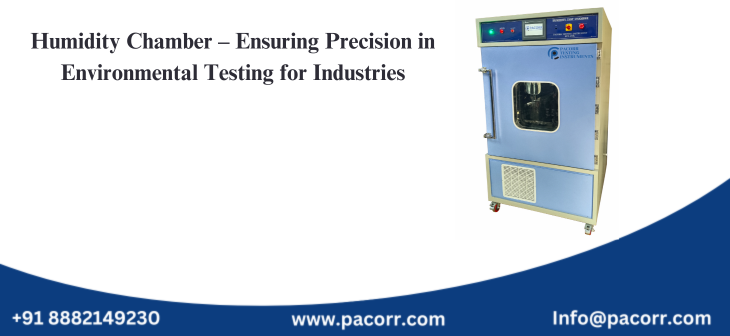
Humidity Chamber plays a crucial role in modern manufacturing and research, where product performance is heavily influenced by environmental conditions. Also known as a Conditioning Chamber, this sophisticated testing instrument is designed to simulate real-world temperature and humidity variations, allowing industries to evaluate the durability, reliability, and material behavior of various products before they reach the market.
By replicating extreme climatic conditions, a Humidity Chamber helps manufacturers detect potential weaknesses in materials, coatings, adhesives, and electronic circuits, ensuring that products can withstand diverse environmental stresses. Whether in automotive components, pharmaceuticals, textiles, or electronics, controlled humidity and temperature testing is an essential part of quality assurance.
How a Humidity Chamber Functions
A Humidity Chamber operates by precisely controlling two primary factors—temperature and humidity levels—within a sealed environment. These chambers use a combination of heating, cooling, humidification, and dehumidification systems to create specific environmental conditions that mimic real-world climates, from the driest deserts to the most humid tropical zones.
The fundamental components that ensure precision and stability in a Humidity Chamber include:
- Temperature Control System: Equipped with heating and cooling mechanisms, the chamber can raise or lower temperatures with high accuracy, allowing users to simulate extreme hot or cold conditions.
- Humidity Regulation System: A built-in humidifier and dehumidifier adjusts moisture levels, ensuring precise humidity control between 10% and 98% Relative Humidity (RH) depending on testing requirements.
- Air Circulation Mechanism: Uniform air distribution is crucial for maintaining consistency across the test samples. Advanced models use high-efficiency fans and ventilation systems to ensure even airflow.
- Digital Control Panel & Programmability: Modern Conditioning Chambers feature intelligent controllers with touchscreen interfaces, programmable test cycles, and real-time monitoring to allow users to create customized environmental simulations.
Through these systems, the chamber can replicate seasonal variations, rapid climate changes, and extreme humidity fluctuations, providing a controlled testing platform for various industries.
Significance of Humidity Testing in Manufacturing and Research
Humidity plays a critical role in determining material strength, adhesion, expansion, contraction, and overall durability. Products that are not adequately tested for humidity resistance may fail prematurely, leading to customer dissatisfaction, recalls, and financial losses.
The primary reasons industries invest in Humidity Chambers include:
Material Performance & Durability Assessment
Materials such as plastics, metals, textiles, composites, and adhesives react differently to moisture and temperature variations. A Humidity Chamber helps analyze how materials expand, contract, or degrade when subjected to prolonged humidity exposure, ensuring that only high-quality materials are used in manufacturing.
Corrosion & Rust Prevention in Metals
Metals are highly susceptible to oxidation and rusting when exposed to high humidity. By simulating humid environments, manufacturers can test anti-corrosion coatings, plating materials, and protective layers to ensure long-term resistance against environmental damage.
Testing in Electronics & Semiconductors
Humidity poses a significant threat to electronic devices, as excessive moisture can cause short circuits, insulation failure, and component degradation. Semiconductor manufacturers use Humidity Chambers to evaluate the resilience of circuit boards, sensors, and microchips under fluctuating humidity levels.
Pharmaceutical & Biomedical Stability Studies
The pharmaceutical industry relies heavily on environmental testing to assess drug stability and packaging integrity under humid conditions. Even minor moisture exposure can alter the chemical composition of medicines, reducing their efficacy. Conditioning Chambers are essential for ensuring compliance with stringent international pharmaceutical standards.
Textile & Packaging Industry Applications
Humidity affects textile fibers, causing shrinkage, fading, or weakening of fabrics. Similarly, in packaging, excessive moisture can compromise the integrity of cartons, labels, and adhesives. Humidity Chambers help industries develop moisture-resistant materials and coatings, preventing deterioration during storage and transit.
Advanced Features in Modern Humidity Chambers
With technological advancements, Humidity Chambers are now equipped with high-precision control mechanisms that offer superior performance and efficiency. Some of the latest innovations include:
- Programmable Testing Cycles: Users can set multi-step humidity and temperature profiles, allowing for automated, long-term testing of product samples.
- Energy-Efficient Operation: Modern chambers optimize power consumption while maintaining stable conditions, making them cost-effective for continuous operation.
- Eco-Friendly Refrigerants: Many chambers now use CFC-free refrigerants, reducing their environmental impact while ensuring compliance with global sustainability standards.
- Rapid Climatic Transition Testing: Some models allow for sudden temperature and humidity shifts, mimicking real-world weather changes in a controlled manner.
Challenges Faced in Humidity Testing & Their Solutions
Despite their advanced capabilities, Humidity Chambers come with certain challenges that manufacturers must address to ensure accurate results. Some of these include:
- Maintaining Calibration Accuracy: Regular calibration of sensors, temperature controllers, and humidity regulators is necessary to prevent fluctuations in readings.
- Condensation & Water Management: Excessive moisture buildup inside the chamber can affect test samples. Modern chambers incorporate anti-condensation technology to mitigate this issue.
- Material Sensitivity & Test Duration: Some materials require extended exposure times to properly evaluate their humidity resistance. Advanced chambers allow for long-duration testing with real-time monitoring.
Why Investing in a Humidity Chamber is Essential
In today’s industrial landscape, where product reliability and compliance with international standards are non-negotiable, a Humidity Chamber is an invaluable asset for manufacturers. By accurately simulating real-world environmental conditions, these chambers help industries enhance product longevity, optimize material selection, and reduce failure rates before products enter the market.
Whether in automotive, aerospace, pharmaceuticals, electronics, or textiles, integrating Humidity Chambers into the quality control process is a strategic decision that ensures consistent performance, regulatory compliance, and customer satisfaction. With ongoing technological advancements, modern Conditioning Chambers continue to revolutionize the way industries approach environmental testing, providing precision, efficiency, and reliability in product evaluation.
Thanks to Pacorr Testing instruments, we have all the required quality testing instruments that have helped us to ensure the best quality delivered to our clients.

Danish
Fair Exports Pvt. Ltd.

